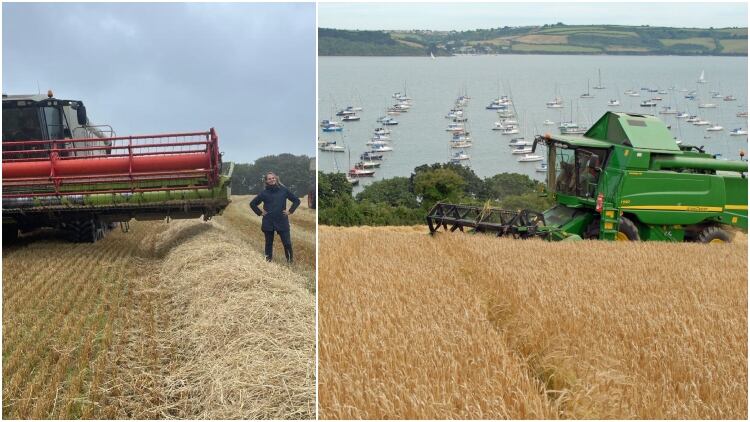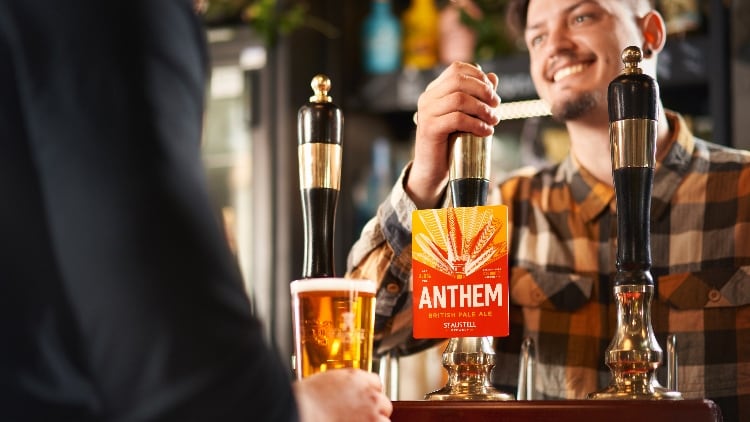It’s a simple idea, but an important one: “We know where our ingredients come from, and we work with farmers and suppliers to understand how they’re growing barley and hops in a way that’s thoughtful of the environment,” says Young, adding: “this is key to our focus on sustainability, British ingredients, and, of course, cask ale.”
Every beer sustainability story begins in the soil, and it always ends with a beer being drunk and the packaging recycled or reused. “For us, this is about making connections between the grower in the field and the drinker in the pub,” says Young. “That’s why Anthem has become an important beer for us.”
Creating a British Anthem
St Austell’s Anthem is a 3.8% ABV golden ale brewed with Cornish barley and modern British hops, and it was a recipe which Young had been thinking about for years before she finally made it in early 2022.
“Anthem focuses very much on the Cornish gold barley, but keeping the malt recipe very simple so you can then showcase the wonderful flavours of the British hops,” she says. The hop varieties in Anthem are Jester, Olicana, Harlequin and Endeavour, all of which have been bred (by grower-owned hop merchant Charles Faram) to have strong aromas, which Young describes as giving the beer “tropical fruits, stone fruits, pomegranate, blackcurrant and citrus zest flavours.”
Beer is a relatable way of being able to talk about St Austell’s sustainability goals. “As a brewer we need to get to net zero by 2040,” says Elle Sambrook, head of sustainability for St Austell (pictured below). “The raw ingredients are a big source of emissions, especially fertilisers and fuel for machinery, which is why we want to be actively working with growers.”

Supporting Cornish barley
“Our soil is the most valuable asset we’ve got. If you don’t look after it, you’re knackered,” says Matthew Dale, who grows malting barley for St Austell Brewery at Restronguet Barton Farm in Cornwall, where his family have farmed since the 1870s.
Dale remembers conversations in the early 2000s with St Austell’s then head brewer Roger Ryman who wanted “Cornish beer made with Cornish barley, building relationships with the farmers, and knowing where the barley’s come from,” Dale says. That relationship went beyond a grower-producer transaction. “The head brewer can jump in the car and drive to any number of farms and see the barley that’s going into the beer. It’s that ethos that Georgina’s carrying on,” he says.
“We want to be able to have these personal conversations with growers as it means we can then have conversations with drinkers, and share those stories to help more people understand about a beer’s environmental impact,” says Young. For Sambrook, “it’s a way to discuss how farming processes can lead to an environment benefit alongside growing ingredients.”
Dale grows barley using what has become known as regenerative farming techniques, “but that’s just traditional rotational farming under a new sexy name,” he says. “It’s just good practice looking after your land.”
One of the key practices involves planting a cover crop directly after the barley harvest, which grow when the land may otherwise by bare. In nature there’s no bare soil, and now over the autumn months the plants grow, they take carbon from the atmosphere and lock it within the soil, providing nutrients which then help to make next year’s barley more resilient, while requiring less fertiliser and less tractor fuel from reduced ploughing, and increasing biodiversity in the fields. “It’s good for the soil, which is good for the crops, which is good for me, and for the beer,” says Dale.

Celebrating British hops
Hops don’t grow in Cornwall, so St Austell source their hops from growers in Worcestershire and Kent. Just like barley, “if one is thinking about farming long-term sustainably, one has to start with the soil,” says Ali Capper, hop grower and Director of the British Hop Association. And that’s led more growers to introduce cover crops between their hop rows. “More than half of the British hop industry is now using cover crops,” says Capper, often growing plants like rye and black oat.
“It’s good for the soil, and it’s also introducing biodiversity into what is a monoculture crop,” Capper says. Next is a project looking at what wildflowers could work, and whether they could attract predators like ladybirds which eat some of the pests.
The on-farm changers works alongside breeding priorities which are looking to find new British hops. “We want a British Citra,” says Capper, meaning a hop that’s got an intense aroma, while also being able to grow in changing British weather. Some of the successes of the hop breeding have given us varieties like Jester, Olicana, Harlequin and Endeavour, and there’s a lot of excitement for varieties which are expected to be available in coming years.
Capper and the other growers are only able to commit to these processes and planting potential new varieties if British brewers are committed to buying the hops. St Austell were among the first to brew trial batches with some of the newer hops, particularly Harlequin, and it was those trials which inspired the hop additions for Anthem.
Back to the pub
As well as championing Cornish barley and showing off the bold flavours of modern British hop varieties, Anthem was conceived as a beer to encourage people to the pub. “It’s only on cask, and we’re committed to it being on cask,” says Young, and it’s had a successful summer: “it’s exceeding our expectations, and doing even better than expected.”
Of all the ways for someone to drink beer, local cask ale, made with local ingredients, drunk in the local pub, “is by far the most sustainable choice,” says Young. “It’s the most natural form of beer that there is, and it should appeal to the same consumer that’s very conscious about the environment,” says Young. As drinkers and pub-goers become more considerate of provenance and sustainability, the pub can have an important role in explaining why all this matters.
“The biggest thing that pubs can do is work on conversations with their customers,” says Sambrook. “What is the provenance of this beer? Why is it important? Why does it taste like that? Why is it more sustainable?” she says. “Pubs can educate on why it’s important, and to create that demand for these British beers.”
Sustainability is a collaboration, and the brewery sits in the middle of it all, working with growers, pubs, and drinkers, because making meaningful changes requires a collective effort, and while some of those conversations may be complex and hard to fully comprehend, the beer itself can become something which enables progress, because that’s something we all understand.
Matthew Dale’s local is the Pandora Inn, overlooking the Restronguet Creek. “To go down to the Pandora and sit there with a pint of St Austell beer knowing there’s every chance my barley’s in that, it’s a nice feeling,” he says. For Young, “it’s nice to know that a beer like Anthem is celebrating the great produce of this land,” she says, “while also helping to improve the quality of the land, and help ensure the future of British barley and hops.”




